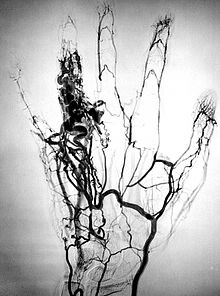| Angioma | |
|---|---|
 | |
| Arteriography showing the blood vessels involved in an angioma of the ring finger | |
| Specialty | Dermatology |
Angiomas are benign tumors derived from cells of the vascular or lymphatic vessel walls (endothelium) or derived from cells of the tissues surrounding these vessels.[1][2]
Angiomas are a frequent occurrence as patients age, but they might be an indicator of systemic problems such as liver disease. They are not commonly associated with cancer.
Signs and symptoms
[edit]
Angiomas usually appear at or near the surface of the skin anywhere on the body, and may be considered bothersome depending on their location. However, they may be present as symptoms of another more serious disorder, such as cirrhosis. When they are removed, it is generally for cosmetic reasons.
Types
[edit]- Naevus flammeus
- Telangiectasia - Spider, Hereditary hemorrhagic
- Reactive vascular proliferations
See also
[edit]References
[edit]- ^ Robbins and Cotran, "Pathologic Basis of Disease", by Ninay Kumar, Abul K. Abbas, Nelson Fausto, 7th Edition, pages 545-547
- ^ "angioma" at Dorland's Medical Dictionary
Well, that’s interesting to know that Psilotum nudum are known as whisk ferns. Psilotum nudum is the commoner species of the two. While the P. flaccidum is a rare species and is found in the tropical islands. Both the species are usually epiphytic in habit and grow upon tree ferns. These species may also be terrestrial and grow in humus or in the crevices of the rocks.
View the detailed Guide of Psilotum nudum: Detailed Study Of Psilotum Nudum (Whisk Fern), Classification, Anatomy, Reproduction